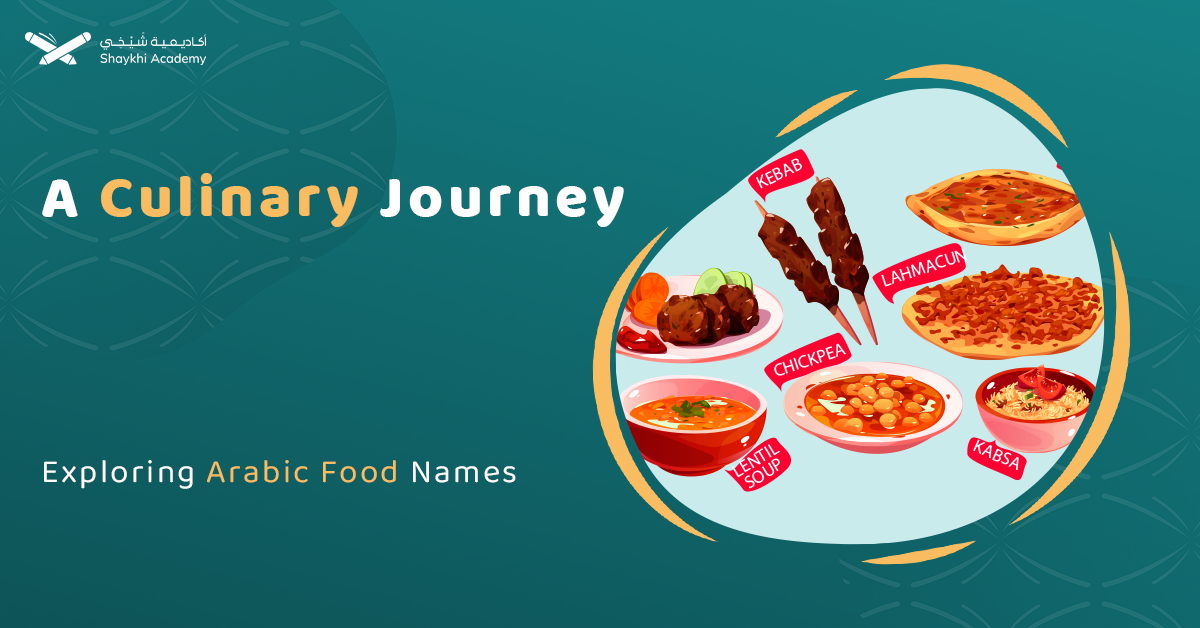Arabic cuisine is a treasure trove of flavors, with each dish reflecting the rich history and diverse culture of the Arab world. Whether it’s the earthy spices, the vibrant colors, or the mix of ingredients, Arabic food offers a unique culinary experience.
In this article, we explore a comprehensive list of Arabic food names, specifically focusing on popular dishes from Egyptian cuisine. From rice and grain-based meals to sweet desserts and refreshing beverages, these names will help you immerse yourself in the world of Arabic gastronomy.
A List of Arabic Food Names
Egyptian cuisine is a vibrant reflection of the country’s rich cultural heritage and diverse agricultural resources. In most Egyptian Arabic courses, not only language but cultural items such as food are discussed. This table provides a comprehensive list of popular Egyptian foods:
1. Rice and Grains Food Dishes in Arabic:
| No. | Arabic Name | English Translation | Transliteration |
| 1 | كشري (Koshari) | A rice and lentil dish with pasta and tomato sauce | Koshari |
| 2 | ملوخية (Molokhia) | A stew made from jute leaves, typically served with rice and meat | Molokhiya |
| 3 | محشي (Mahshi) | Stuffed vegetables, typically zucchini or grape leaves | Mahshi |
| 4 | بامية (Bamya) | Okra stew with tomatoes and meat, usually served with rice | Bamya |
| 5 | معكرونة بالبشاميل (Macarona bil Béchamel) | Pasta with béchamel sauce, often with minced meat | Macarona bil Béchamel |
| 6 | رز باللبن (Roz bil Laban) | Rice pudding with milk | Roz bil Laban |
2. Meat and Fish Food Dishes in Arabic:
| No. | Arabic Name | English Translation | Transliteration |
| 7 | سمك مكرل (Samak Makaral) | Grilled or fried mackerel fish | Samak Makaral |
| 8 | كبدة (Kibda) | Fried liver, usually served with bread | Kibda |
| 9 | قلقاس (Qulqas) | Taro root stew with meat, usually lamb | Qulqas |
| 10 | مشاوي (Mashawy) | Grilled meats, typically served with rice or bread | Mashawy |
| 11 | لحمة مكعبات (Lahma Mukababat) | Diced meat, often cooked with vegetables and spices | Lahma Mukababat |
| 12 | فريسكا (Freska) | Fried or grilled fish, typically tilapia or bass | Freska |
3. Vegetables and Legumes Food in Arabic:
| No. | Arabic Name | English Translation | Transliteration |
| 13 | فلافل (Falafel) | Deep-fried balls made from chickpeas or fava beans | Falafel |
| 14 | طعمية (Ta’amiyya) | Egyptian-style falafel made from fava beans | Ta’amiyya |
| 15 | ساندويش فول (Sandwich Fool) | A sandwich made with mashed fava beans | Sandwich Fool |
| 16 | سلطة (Salata) | Mixed vegetable salad, often served with tahini dressing | Salata |
| 17 | باذنجان مقلي (Badhinjan Maqli) | Fried eggplant, typically served as a side dish | Badhinjan Maqli |
| 18 | ملوخية باللحم (Molokhia bil Lahm) | Molokhia with meat, usually chicken or beef | Molokhiya bil Lahm |
4. Soups and Stews Food in Arabic:
| No. | Arabic Name | English Translation | Transliteration |
| 19 | شوربة عدس (Shorbat Adas) | Lentil soup, a common Egyptian dish | Shorbat Adas |
| 20 | طاجن (Tajine) | A slow-cooked stew, often made with meat, vegetables, and spices | Tajine |
| 21 | شوربة خضار (Shorbat Khudar) | Vegetable soup, made with various seasonal vegetables | Shorbat Khudar |
| 22 | شوربة لحم (Shorbat Lahm) | Beef or lamb soup, typically served with vegetables | Shorbat Lahm |
| 23 | شوربة فراخ (Shorbat Farakh) | Chicken soup, often served with rice or bread | Shorbat Farakh |
5. Desserts in Arabic::
| No. | Arabic Name | English Translation | Transliteration |
| 24 | بسبوسة (Basbousa) | A semolina cake soaked in syrup | Basbousa |
| 25 | كنافة (Knafeh) | A dessert made with shredded dough, cheese, and syrup | Knafeh |
| 26 | قطايف (Qatayef) | A dessert made from stuffed dough, usually with nuts or sweet cheese | Qatayef |
| 27 | رز بلبن (Roz bil Laban) | Rice pudding made with milk and sugar | Roz bil Laban |
| 28 | بلاليط (Balalit) | A sweet vermicelli dish, typically served for breakfast | Balalit |
| 29 | عسلية (Asliya) | A sweet pastry filled with nuts and syrup | Asliya |
6. Beverages in Arabic:
| No. | Arabic Name | English Translation | Transliteration |
| 30 | قهوة عربية (Qahwa Arabiya) | Traditional Arabic coffee | Qahwa Arabiya |
| 31 | شاي (Shay) | Tea, often served with sugar and mint | Shay |
| 32 | عصير قصب السكر (Aseer Qasab al-Sukar) | Sugarcane juice | Aseer Qasab al-Sukar |
| 33 | عصير ليمون (Aseer Laymun) | Fresh lemon juice | Aseer Laymun |
| 34 | جلاب (Jallab) | A drink made from dates, grape molasses, and rosewater | Jallab |
| 35 | تمر هندي (Tamar Hindi) | Tamarind drink, often served during Ramadan | Tamar Hindi |
7. Salads and Sides in Arabic:
| No. | Arabic Name | English Translation | Transliteration |
| 36 | حمص (Hummus) | A chickpea dip with tahini | Hummus |
| 37 | سلطة الطحينة (Salatat al-Tahina) | A sesame paste salad, often served as a dip | Salatat al-Tahina |
| 38 | سلطة بابا غنوج (Salatat Baba Ghanouj) | Eggplant dip with tahini | Salatat Baba Ghanouj |
| 39 | تبولة (Tabbouleh) | A parsley, tomato, and bulgur salad | Tabbouleh |
| 40 | فتوش (Fattoush) | A salad made with mixed greens and crispy pita | Fattoush |
| 41 | زبادي (Zabadi) | Yogurt, often served as a side or dip | Zabadi |
How to Learn Arabic Food Names?
Learning Arabic food names can be a fun and rewarding experience, especially if you’re interested in exploring Arabic culture or expanding your vocabulary in the language. Here are some effective strategies to help you learn Arabic food names:
1. Start with Common and Basic Foods
Begin with everyday food items that you are familiar with, such as fruits, vegetables, and common dishes. Familiarity with these terms will help you build a foundation.
Focus on categories like fruits, vegetables, meats, desserts, and drinks. For example, learning “تفاح” (tuffah) for apple and “برتقال” (burtuqal) for orange can be a good starting point.
2. Use Flashcards
Flashcards are a great way to learn and memorize new words. You can create flashcards with the Arabic word on one side and the English translation or picture on the other. Digital flashcard apps like Anki or Quizlet can also help reinforce your learning with spaced repetition.
3. Watch Arabic Cooking Shows or Videos
Watching Arabic cooking shows or food-related videos can expose you to food names in context. Listening to native speakers and watching the preparation process will help you remember the names associated with the dishes. Platforms like YouTube or Arabic TV channels can be valuable resources.
4. Learn Pronunciation and Transliteration
It’s important to learn the correct pronunciation of the words. Use online resources or language apps that provide both transliterations and audio pronunciations. This will help you speak and recognize the food names more accurately.
5. Practice with a Native Speaker
Practicing speaking with a native Arabic speaker can enhance your language skills and help you retain food names. Join Arabic group classes to communicate with Arab natives and immerse yourself in their culture. They can correct your pronunciation and introduce local variations of food names in different Arabic dialects.
6. Use Language Learning Apps
Many apps are designed specifically to teach vocabulary, including food names. Apps like Duolingo, Rosetta Stone, or Memrise include sections on food and drink vocabulary and often feature interactive exercises to reinforce learning.
7. Label Items in Your Kitchen
Label the food items in your kitchen or dining area with their Arabic names. This will help you remember the words as you interact with these items daily.
8. Study Egyptian and Regional Specialties
If you’re particularly interested in Egyptian cuisine, learn food names that are unique to that region. Dishes like “كشري” (koshari), “ملوخية” (molokhiya), and “فول مدمس” (foul medames) are central to Egyptian meals and provide insight into local culture.
9. Make a Food Vocabulary Notebook
Keep a dedicated notebook where you write down new food-related vocabulary. Include the Arabic word, its transliteration, and its English translation. You can also add pictures of the food to make it easier to remember.
10. Immerse Yourself in Arabic Food Culture
If possible, attend Arabic cooking classes, visit Arabic restaurants, or even travel to Arabic-speaking countries. Experiencing food in its cultural context will give you a deeper understanding and appreciation of the language.
Master Egyptian Arabic Today with Shaykhi Academy!
Ready to dive deeper into the heart of Egypt’s culture through language? Our Learning Egyptian Arabic course is the perfect opportunity to immerse yourself in the authentic Egyptian dialect, enhancing your communication skills and enriching your travel or study experiences.
Start mastering Egyptian Arabic today and gain confidence in speaking, reading, and understanding one of the most widely spoken dialects in the Arab world.
Enroll now at Learning Egyptian Arabic and take the first step toward fluency!
Why Shaykhi Academy?
- Expert Native Tutors: Learn from highly qualified native Arabic speakers.
- Flexible Scheduling: Tailor your classes to fit your busy life.
- Affordable Learning: Access top-quality education at a price that suits you.
- Global Access: Study from anywhere in the world.
Explore Our Arabic Courses:
- Noorani Qaida: Build a strong foundation in Quranic Arabic.
- Comprehensive Arabic Courses: Master the Arabic language, from beginner to advanced levels.
- Fusha Arabic Classes: Delve into Modern Standard Arabic, the key to understanding literature, media, and formal communication across the Arab world.
- Quranic Arabic Course: Enhance your connection with the Quran by learning the language in which it was revealed.
Start Your Arabic Journey Today! Whether you’re just starting or looking to deepen your knowledge, Shaykhi Academy is here to support your journey. Book your free trial now and begin your path to Arabic mastery!

The Conclusion:
Learning Arabic food names not only enhances your language skills but also connects you with the culture and traditions of the Arabic-speaking world. By familiarizing yourself with the names of common dishes, ingredients, and meals, you can deepen your appreciation for Arabic cuisine.
Whether you’re a language learner or simply a food enthusiast, these strategies will help you build your vocabulary and enjoy the delightful world of Arabic foods.

















































